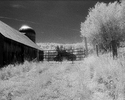As Steve is aware, in a replenishment regime the working solution contains a mixture of both partially exhausted (used up) developing agents and development byproducts that serve as development restrainers. As such, it is less active than one-shot fresh developer, and usually requires longer development times in order to build necessary contrast.
Once you get the system up and running, the working solution is in a sort of steady state - it isn't as active as fresh developer, but it also is far from fully exhausted.
The act of replenishment is a two part action - yes you are adding fresh developer to increase activity, but you are also removing partially exhausted and development byproduct laden developer. Both parts of that action serve to maintain the required activity, and are equally important when one considers the differences between a replenishment regime and the procedure in the data sheet for re-use of an un-replenished volume of developer - gradual increase of development time as you develop more films.
One of the reasons people refer to the published times for using X-Tol 1+1 in a one shot regime when they are discussing using it in a replenishment regime is that the 1+1 times are a decent starting point when you start fine tuning your own personal development times for replenished X-Tol.
I'm just guessing here, but I expect that when you use X-Tol with a film like Ilford Delta 3200 that is designed to be inherently low in contrast, in order to make it perform better when push processed, that the build up of development byproducts in a replenishment regime working solution may have greater affect on the pushability of that film than on more standard emulsions.






